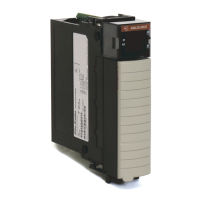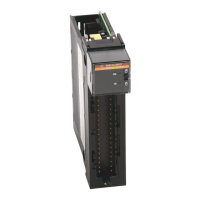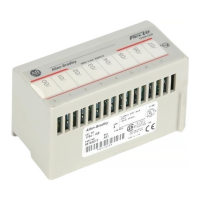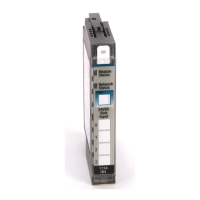Rockwell Automation Publication 1756-UM540E-EN-P - December 2017 97
1756-OF8I Isolated Analog Output Module Chapter 5
Fault and Status Reporting
The 1756-OF8I module multicasts fault and status data with channel data to the
owner and listening controllers. The data is returned via module tags that you can
monitor in your Logix Designer application.
With some exceptions, as noted in the following table, the 1756-OF8I module
provides the fault and data status in a channel-centric format.
The following table lists the 1756-OF8I module’s fault and status tags available
in the Logix Designer application.
Table 21 - 1756-OF8I Module - Fault and Status Data Tags
Data Type Tag Name Triggering Event That Sets Tag
Fault
Fault
(1)
The owner-controller loses its connection to the module.
Ch[x].Fault The channel data quality is bad.
Status
CIPSyncValid
(1)
Indicates whether the module is synchronized to a valid CIP Sync time master on the backplane.
CIPSyncTimeout
(1)
Indicates whether a valid time master on the backplane has timed out.
CIPSyncOffsetJump
(1)
Indicates a significant jump, that is, 1 ms or greater, in the CST and CIP Sync times sent from the Time Master to the
module. (The Time Master sends the CST and CIP Sync times to the module every second.)
When a significant jump occurs, this tag value becomes 1 but changes to 0 a second later unless another jump
occurred.
Ch[x].Uncertain The channel data can be imperfect.
Ch[x].LowClampAlarm The following events occur:
• Clamping is enabled on this channel.
• One of the following:
– The channel data requested, indicated in the O.Ch[x].Data tag, is currently less than the configured LowLimit.
– Latching is enabled and the O:Ch[x].Data tag was less than the configured LowLimit at some points and the
alarm has not been unlatched.
Ch[x].HighClampAlarm The following events occur:
• Clamping is enabled on this channel.
• One of the following:
– The channel data requested, indicated in the O.Ch[x].Data tag, is currently greater than the configured
HighLimit.
– Latching is enabled and the O:Ch[x].Data tag was greater than the configured HighLimit at some points and
the alarm has not been unlatched.
Ch[x].RampAlarm The channel is currently limited to changing the output at the Maximum Ramp rate or once was and is now latched.
Ch[x].NotANumber The most recently-received data value was not a number.
Ch[x].InHold The channel is currently holding until the received channel data is within 0.1% of the current channel data value.
Ch[x].CalibrationFault The channel is not calibrated or the last attempted calibration for this channel failed.
Ch[x].Calibrating The channel is currently being calibrated.
Ch[x].CalGoodLowRef A valid Low Reference signal has been sampled on this channel.
Ch[x].CalBadLowRef An invalid Low Reference signal has been sampled on this channel.
Ch[x].CalGoodHighRef An valid High Reference signal has been sampled on this channel.
Ch[x].CalBadHighRef An invalid High Reference signal has been sampled on this channel.
Ch[x].CalSuccessful Calibration on this channel is complete and the calibrating state has been exited.
Ch[x].Data The channel data in scaled Engineering Units. This data is the Output Data Echo data returned from the D/A convertor.
Timestamp
(1)
A 64-bit Timestamp indicating when any one of the output channels was last updated with new output data in terms
of CIP Sync time.
RollingTimestamp 16-bit timestamp that ‘rolls’ from 0…32,767 ms. Compatible with existing PID instruction to automatically calculate
sample deltas. The timestamp changes when any one of the output channels is updated.
(1) This tag provides module-wide data and affects all channels simultaneously.

